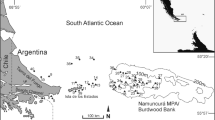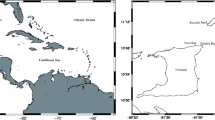Abstract
Epibenthic brittle star assemblages were investigated on the northwestern Barents Sea shelf between 81° and 77°N in July 1991. At 9 drift stations in water depths between 80 and 360 m, series of 35–71 photographs, each depicting about 1 m2 of the seabed, were taken along transects of about 150- to 300-m length to assess abundances and spatial distribution patterns of adult brittle stars (disc diameter ≥1 mm). Biomass values were derived by combining abundances with size-weight relationships and size frequencies established using specimens from trawl catches. Six brittle star species were identified on the seabed images.Ophiocten sericeum was the most abundant species on shallow shelf banks (≤100 m). Up to 2,800 individuals were counted on a single photograph; median abundances per station ranged from 32 to 524 ind.m−2 and biomass from 0.3 to 5.0 g ash-free dry weight (AFDW) m−2. The spatial distribution along the transects (i.e. on the 100-m scale) was, however, extremely patchy. Disc diameters ofO. sericeum ranged between 1.6 mm and 15.4 mm. In deeper shelf habitats (>150 m),O. sericeum was rare or absent, andOphiacantha bidentata dominated the brittle star fauna with median densities and biomasses of 2–49 ind.m−2 and 0.07–1.9 g AFDW m−2, respectively. Its disc diameters ranged from 2.9 to 14.4 mm. The other species (Ophiura sarsi, Ophiopholis aculeata, Ophioscolex glacialis, Ophiopleura borealis) occurred in distinctly lower numbers. Our findings provide further evidence that brittle stars dominate epibenthic communities on Arctic shelves and locally reach very high abundances. Dense beds ofOphiocten sericeum seem to be a general phenomenon on high-Arctic shallow shelf banks.
Similar content being viewed by others
References
Anisimova NA (1989) Distribution patterns of echinoderms in the Eurasian sector of the Arctic Ocean. In: Herman Y (ed) The Arctic seas. Van Nostrand, New York, pp 281–301
Aronson RB, Sues HD (1987) The paleoecological significance of an anachronistic community. In: Kerfoot WC, Sih A (eds) Predation: direct and indirect impacts on aquatic communities. University Press of New England, Hanover, pp 355–366
Blaber SJM, May NJ, Young JW, Bulman CM (1987) Population density and predators ofOphiacantha fidelis (Koehler, 1930) (Echinodermata: Ophiuroidea) on the continental slope of Tasmania. Aust J Mar Freshwater Res 38:243–247
Blacker RW (1957) Benthic animals as indicators of hydrographic conditions and climatic change in Svalbard waters. Fishery Investigations 20:1–49
Carey AG (1991) Ecology of the North American Arctic continental shelf benthos: a review. Cont Shelf Res 11:865–883
D’yakonov AM (1967) Ophiuroids of the USSR seas. Keys Fauna USSR 55:1–122
Elliot JM (1971) Some methods for the statistical analysis of samples of benthic invertebrates. Sci Publ Freshwater Biol Assoc 25:1–144
Ellis DV (1960) Marine infaunal benthos in Arctic North America. Arct Inst North Am Tech Pap 5:1–53
Fujita T, Ohta S (1989) Spatial structure within a dense bed of the brittle starOphiura sarsi (Ophiuroidea: Echinodermata) in the bathyal zone of Otsuchi, Northeastern Japan. J Oceanogr Soc Japan 45:289–300
Graf G (1992) Benthic-pelagic coupling: a benthic view. Oceanogr Mar Biol Annu Rev 30: 149–190
Grebmeier JM, Barry JP (1991) The influence of oceanographic processes on pelagic-benthic coupling in polar regions: a benthic perspective. J Mar Systems 2:495–518
Hebbeln D, Wefer G (1991) Effects of ice coverage and ice-rafted material on sedimentation in the Fram Strait. Nature 350:409–411
Holme NA, McIntyre AD (1984) Methods for study of the marine benthos. Blackwell, Oxford
Lloyd M (1967) Mean crowding. J Anim Ecol 36:1–30
Loeng H (1989) Ecological features of the Barents Sea. In: Rey L, Alexander V (eds) Proceedings of the sixth conference of the Comité Arctique International 13–15 May 1985. Brill, Leiden, pp 327–365
Mortensen T (1927) Handbook of the echinoderms of the British Isles. Oxford University Press, Edinburgh
Muus K (1981) Density and growth of juvenileAmphiura filiformis (Ophiuroidea) in the Øresund. Ophelia 20:153–168
Paterson GLJ (1985) The deep-sea Ophiuroidea of the North Atlantic Ocean. Bull Br Mus Nat Hist (Zool) 49:1–162
Paterson GLJ, Tyler PA, Gage JD (1982) The taxonomy and zoogeography of the genusOphiocten (Echinodermata: Ophiuroidea) in the North Atlantic Ocean. Bull Br Mus Nat Hist Zool 43:109–128
Pfannkuche O, Thiel H (1987) Meiobenthic stocks and benthic activity on the NE-Svalbard shelf and in the Nansen Basin. Polar Biol 7:253–266
Piepenburg D (1989) Absolute densities and spatial distribution patterns of epibenthic species from the Fram Strait. Rapp PV Réun Cons Perm Int Explor Mer 188:188
Piepenburg D, Juterzenka K von (1994) Abundance, biomass and spatial distribution patterns of brittle stars (Echinodermata: Ophiuroidea) on the Kolbeinsey Ridge north of Iceland. Polar Biol 14:185–194
Piepenburg D, Blackburn TH, Dorrien CF von, Gutt J, Hall POJ, Hulth S, Kendall MA, Opalinski KW, Rachor E, Schmid MK (1995) Partitioning of benthic community respiration in the Arctic (northwestern Barents Sea). Mar Ecol Prog Ser 118:199–213
Piepenburg D, Chernova NV, Dorrien CF von, Gutt J, Neyelov AV, Rachor E, Saldanha L, Schmid MK (1996) Megabenthic communities in the waters around Svalbard. Polar Biol 16:431–446
Rachor E (1992) Scientific cruise report of the 1991 Arctic expedition ARK VIII/2 of RV “Polarstern”. Ber Polarforsch 115:1–150
Rey F, Loeng H (1985) The influence of ice and hydrographic conditions on the development of phytoplankton in the Barents Sea. In: Gray JS, Christiansen ME (eds) Marine biology of polar regions and effects of stress on marine organisms. Wiley, Chichester, pp 49–63
Rice AL, Aldred RG, Darlington E, Wild RA (1982) The quantitative estimation of the deep-sea megabenthos: a new approach to an old problem. Oceanol Acta 5:63–72
Romero-Wetzel M, Gerlach S (1991) Abundance, biomass, size distribution and bioturbation potential of deep-sea macrozoobenthos on the Vøring Plateau (1200–1500 m, Norwegian Sea). Meeresforschung 33:247–265
Salzwedel H, Rachor E, Gerdes D (1985) Benthic macrofauna communities in the German Bight. Veröff Inst Meeresforsch Bremerhaven 20:199–267
Schauer U (1992) Physical oceanography. In: Rachor E (ed) Scientific cruise report of the 1991 Arctic expedition ARK VIII/2 of RV “Polarstern”. Ber Polarforsch 115:21–31
Schmid MK (1994) Zur Verbreitung und Respiration ökologisch wichtiger Bodentiere in den Gewässern um Svalbard (Arktis). PhD Thesis, Kiel University
Slagstad D (1985) A model of phytoplankton in the marginal ice zone of the Barents Sea. In: Gray JS, Christiansen ME (eds) Marine biology of polar regions and effects of stress on marine organisms. Wiley, Chichester, pp 35–48
Smith CR, Hamilton SC (1983) Epibenthic megafauna of a bathyal basin off southern California: patterns of abundance, biomass, and dispersion. Deep-Sea Res 30:907–928
Strass V, Nöthig E-M (1996) Seasonal ice edge phytoplankton bloom migration in the Barents Sea related to water column stability. Polar Biol
Thurston MH, Bett BJ, Rice AL, Jackson PAB (1994) Variations in the invertebrate abyssal megafauna in the North Atlantic Ocean. Deep-Sea Res 41:1321–1348
Zenkevitch L (1963) Biology of the seas of the USSR. Allen & Unwin, London
Author information
Authors and Affiliations
Additional information
The data presented were collected during the European “Polarstern” Study (Arctic EPOS) sponsored by the European Science Foundation
Rights and permissions
About this article
Cite this article
Piepenburg, D., Schmid, M.K. Brittle star fauna (Echinodermata: Ophiuroidea) of the arctic northwestern Barents sea: composition, abundance, biomass and spatial distribution. Polar Biol 16, 383–392 (1996). https://doi.org/10.1007/BF02390420
Received:
Accepted:
Issue Date:
DOI: https://doi.org/10.1007/BF02390420




